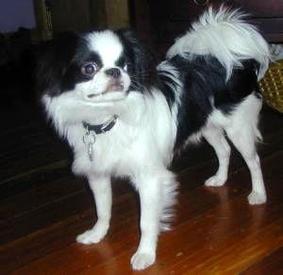
Originating in Asia roughly 1,500 years ago, the Japanese Chin developed in the imperial court of Japan where it was highly prized as a portable novelty dog. Otherwise known as the Pekingese or Japanese Spaniel, the breed was often gifted to visiting nobles and diplomats, increasing the prevalence within its native country. Introduced to America in 1854, the breed gained a large following, becoming a highly sought companion and lap dog amongst the wealthy and noble. In 1853, a pair of Japanese Chin were gifted to the dog-loving Queen Victoria by Commodore Perry as he opened the country to world trade. Officially recognised by the American Kennel Club in 1888.
Falling within the 'toy' branch of canines, the Japanese Chin boasts miniature proportions, with short legs, a distinctive 'squashed' expression, and a feathered tail held high over the back. The Chin's head is typically broad with wide-set eyes and a short muzzle. The coat type is long and soft, common in colour variations of white with red, orange, lemon, sable, tan, brindle or black markings. Daily grooming will benefit the appearance, condition and manageability of the coat, whilst bathing should only be done when needed.
A lively and contented breed, well suited to active family life. Whilst being friendly and obedient towards its owners, the Japanese Chin can display a certain reticence around strangers so early socialisation is important. Besides this, firm leadership and consistent training is recommended, helping your dog to achieve its pleasing potential. Susceptible to separation anxiety and Small-Dog Syndrome, the Japanese Chin should be gradually conditioned to expect short absences and adapt to them without fuss. On average, an adult Japanese Chin will weigh 2-7 kg depending on its gender, with a life expectancy of 10-12 years.
For a toy breed, the Japanese Chin is relatively healthy and low maintenance. Certain ailments are identified, however, including various optical disorders ranging from cataracts to progressive retinal atrophy, and orthopedic complaints. Luxating patellas and hip dysplasia are commonly seen in the breed, which may require surgical correction, as well as mitral valve disease affecting the heart.
Do you own a Japanese Chin? Let others know what they're like!
Related products
Dog Gone Smart Suede Quilted Belly Coat Red
from £14.83
Advantage 80 Spot On Flea Control Large Cats and Rabbits
from £10.89
Advantage 40 Spot On Flea Control Cats, Small Dogs and Rabbits
from £10.89
Advantage 100 Spot On Flea Control Medium Dog
from £10.89
Drontal Tasty Bone Wormer Tablets for Small & Medium Dogs (2 to 20kg)
from £1.69
Advantage 250 Spot On Flea Control Large Dog
from £10.89
FRONTLINE Plus Flea & Tick Treatment Dogs & Cats
from £16.29
TermaWorm™ Tablets for Cats & Dogs
from £1.59